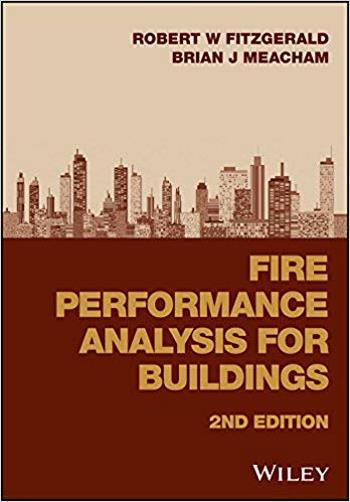نام کتاب: Fire Performance Analysis for Buildings
نویسنده: Robert W. Fitzgerald و Brian J. Meacham
ویرایش: ۲
سال انتشار: ۲۰۱۷
فرمت: PDF
تعداد صفحه: ۶۴۰
کیفیت کتاب: OCR
انتشارات: Wiley
Description About Book Fire Performance Analysis for Buildings From Amazon
A building fire is dynamic. A continually changing hostile fire environment influences time relationships that affect fire defenses and risks to people and building functions. The fire and fire defenses in each building interact with different sequences and distinct ways. Risks are characterized by the building’s performance.
Significantly updated and restructured new edition
Fire Performance Analysis for Buildings, 2nd ویرایش organizes the complex interactions into an analytical framework to evaluate any building – at any location – built under any regulatory jurisdiction or era. Systematic, logical procedures evaluate individual component behavior and integrate results to understand holistic performance. The Interactive Performance Information (IPI) chart structures complex time-related interactions among the fire, fire defenses, and associated risks. Quantification uses state-of-the-art deterministic methods of fire safety engineering and fire science. Managing uncertainty is specifically addressed.
Key features:
- Emphasizes fire performance analysis for new or existing buildings.
- Augments fire dynamics calculation methods with qualitative methods to form a more complete understanding of the effects of hostile fire characteristics on building performance.
- Describes fire ground operations for engineers with no fire service experience. An analysis evaluates ways the site and building design help or hinder manual fire suppression.
- Establishes a transition from traditional structural requirements to modern calculation based structural analysis and design for fire conditions. Structural concepts are described for non-structural engineers to enable the roles of each profession to be integrated into comprehensive performance evaluations.
- Addresses techniques of managing uncertainty to improve understanding and communication with professionals of other disciplines.
- Describes methods of risk management using information from the building’s performance analysis.
Fire Performance Analysis for Buildings, 2nd ویرایش has been completely restructured around a performance based framework. Applications integrate traditional fire defenses with fire science and engineering to combine component performance with holistic performance.
درباره کتاب Fire Performance Analysis for Buildings ترجمه شده از گوگل
آتش سوزی پویا است. یک محیط آتش دشمن به طور مداوم در حال تغییر است که روابط زمان را تحت تاثیر قرار می دهد که بر سیستم های آتش نشانی و خطراتی که برای مردم ایجاد می کند و تأثیرات آنها را تأثیر می گذارد. آتش و آتش در هر ساختمان با توالی های مختلف و روش های متفاوتی ارتباط برقرار می کنند. ریسک ها با عملکرد ساختمان مشخص می شوند.
نسخه جدید به طور قابل توجهی به روز شده و بازسازی شده است
تجزیه و تحلیل عملکرد آتش برای ساختمان، نسخه ۲، تعامل پیچیده را به یک چارچوب تحلیلی برای ارزیابی هر ساختمان – در هر مکان – ساخته شده در هر قضایی و یا دوره نظارتی سازماندهی شده است. رویه های سیستماتیک و منطقی، رفتار مولفه های فردی را بررسی می کنند و نتایج را برای درک عملکرد جامعانه تلفیق می کنند. نمودار عملکرد تعاملی (IPI) تعاملات پیچیده زمانی را در میان آتش، آتش سوزی و خطرات مربوط به آن ایجاد می کند. Quantification با استفاده از روش های جبرگرایانه ای از مهندسی آتش نشانی و علم آتش نشانی به کار می رود. مدیریت عدم قطعیت به طور خاص مورد توجه قرار گرفته است.
ویژگی های کلیدی:
تجزیه و تحلیل عملکرد آتش را برای ساختمان های جدید یا موجود برجسته می کند.
روش های محاسبه پویایی آتش با استفاده از روش های کیفی به منظور ایجاد یک درک کامل از اثرات ویژگی های آتش دشمن بر عملکرد ساختمان.
عملیات آتش زمینی را برای مهندسان بدون تجربه آتش نشانی توصیف می کند. تجزیه و تحلیل ارائه می دهد که چگونه سایت و طراحی ساختمان کمک می کند یا مانع سرکوب آتش دستی می شود.
انتقال از الزامات ساختاری سنتی به تحلیل ساختاری و طراحی طراحی مدرن مبتنی بر مدرن برای شرایط آتش را ایجاد می کند. مفاهیم ساختاری برای مهندسین غیر سازمانی توصیف شده اند تا نقش هر حرفه را در ارزیابی عملکرد جامع ادغام کنند.
به تکنیک های مدیریت عدم قطعیت برای بهبود درک و ارتباط با متخصصان سایر رشته ها اشاره می کند.
روش های مدیریت ریسک را با استفاده از اطلاعات حاصل از تحلیل عملکرد ساختمان توضیح می دهد.
تجزیه و تحلیل عملکرد آتش برای ساختمان ها، نسخه دوم به طور کامل در یک چارچوب مبتنی بر عملکرد تغییر یافته است. برنامه های کاربردی یکپارچه از آتش سوزی آتش با علم آتش و مهندسی برای ترکیب اجزای عملکرد با عملکرد جامع است.
[box type=”info”]![]() جهت دسترسی به توضیحات این کتاب در Amazon اینجا کلیک کنید.
جهت دسترسی به توضیحات این کتاب در Amazon اینجا کلیک کنید.![]() در صورت خراب بودن لینک کتاب، در قسمت نظرات همین مطلب گزارش دهید.
در صورت خراب بودن لینک کتاب، در قسمت نظرات همین مطلب گزارش دهید.

